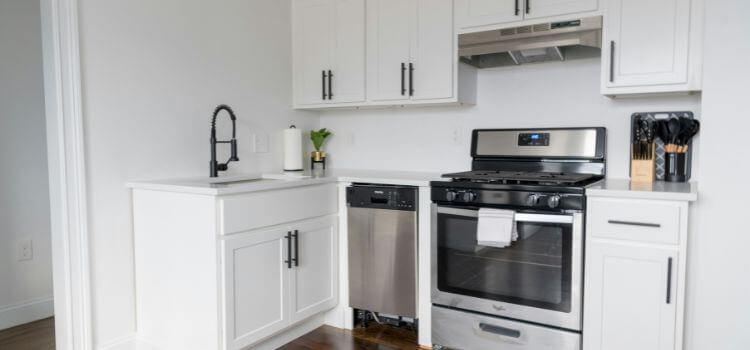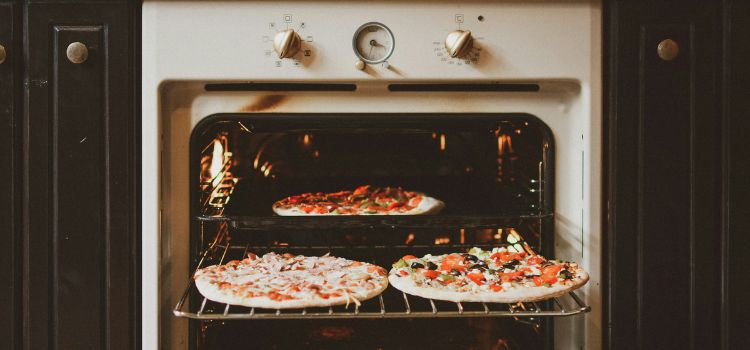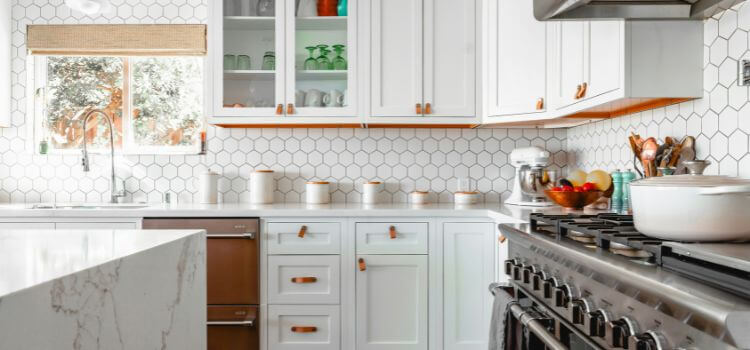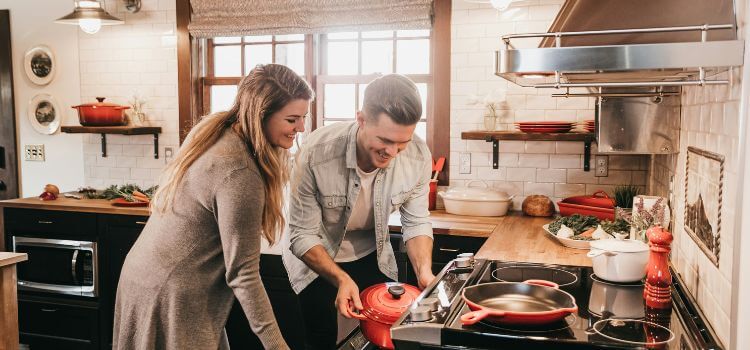As an Amazon Associate, I earn from qualifying purchases

No, you cannot use the stovetop while cleaning the oven with Easy-Off. It is essential to keep the area around the stove clear and free from any flammable materials during cleaning to avoid any potential hazards.
Easy-Off is a popular oven cleaner that helps remove stubborn stains and oil from the oven’s interior. However, following the instructions on the product label carefully is essential to ensure safety and effectiveness. We’ll discuss some pointers about utilizing an Easy-Off oven cleaner and how to clean your oven safely.
Safety First: Using Stove Top During Oven Cleaning
When cleaning your oven with Easy-Off, it’s vital to put safety first, particularly if you intend to use the stovetop simultaneously. Understanding the risks and taking protective measures is crucial to minimize accidents and provide a smooth cleaning process.
Understanding The Risks
- Avoid using the stovetop while the oven is self-cleaning to prevent overheating and potential fire hazards.
- Residual fumes from oven cleaning can be harmful if inhaled, so proper ventilation is critical.
- Excessive heat generated during the oven cleaning cycle can affect the surrounding area, including the stovetop.
Protective Measures To Consider
- Wait for the oven cleaning cycle to complete and cool down before using the stovetop.
- Ensure the kitchen is well-ventilated by opening windows or using an exhaust fan.
- Keep flammable items away from the oven and stovetop while cleaning.
Chemical Composition Of Easy-off
The chemical composition of Easy-Off plays a crucial role in its effectiveness in cleaning ovens and stovetops. Understanding the key ingredients and how these chemicals react to heat is essential to ensure this product’s safe and efficient use.
Key Ingredients
Easy-Off contains several key ingredients that break down tough oven grease and grime. The main active ingredients include:
- Sodium Hydroxide: A powerful alkaline compound that dissolves and emulsifies grease and oil.
- Butane: A fuel that helps disperse the cleaning agents and foam for better coverage.
- Dipropylene Glycol Monobutyl Ether: A solvent that aids in the removal of baked-on food and stains.
- Surfactants help reduce surface tension and lift dirt and grease from the oven surfaces.
How Chemicals React To Heat
When Easy-Off is applied to the oven or stove top, the chemical reaction to heat is initiated. The sodium hydroxide, in particular, becomes activated and breaks down the carbonized food and grease. The chemical response intensifies as the oven heats up during the cleaning process, making it easier to wipe away the grime.
Manufacturer’s Instructions
Avoid cooking on the stove while cleaning the oven with Easy-Off for safe use. Follow the manufacturer’s instructions for optimal results. Use caution to prevent accidents and maintain appliance longevity.
Manufacturer’s Instructions: Recommended Usage: Following the manufacturer’s instructions for using Easy-Off while cleaning your oven is essential. Safety Guidelines: Adhere to safety instructions supplied by the manufacturer to guarantee the secure and efficient use of Easy-Off.
The Anatomy Of A Range

Differentiating Between Oven And Stove Top Components
Understanding the difference between oven and stove top components is crucial for safe and efficient cooking. The oven, also known as the range, is the enclosed space for baking, roasting, and broiling. On the other hand, the stovetop, or cooktop, is a flat cooking surface where you can use pots and pans to cook food. It’s important to note that the oven and stove top have distinct parts and functions.
Heat Distribution In Ranges
Heat distribution in ranges plays a vital role in ensuring even cooking. The oven typically contains heating elements, such as bake and broil elements, which radiate heat for consistent temperature throughout the cooking process. Meanwhile, the stovetop utilizes burners or heating coils that distribute heat evenly to the pots and pans. Understanding how heat is distributed within the range can help achieve perfectly cooked meals.
Potential Hazards
When using Easy-Off to clean your oven, It is essential to comprehend the potential dangers connected to using the stovetop during the cleaning process. Understanding these risks can help you take the required safety measures to guarantee your and your loved ones’ safety in your home.
Chemical Fumes And Ventilation
If inhaled, chemical fumes can be released during the oven cleaning, which may pose a health risk. It’s imperative to guarantee enough ventilation in the kitchen when using Easy-Off. Open windows, turn on exhaust fans and use a respirator mask to minimize exposure to these fumes.
Risk Of Fire And Explosions
Using the stovetop while cleaning the oven with Easy-Off can create fire risk and potential explosions. The oven cleaning process’s high temperatures and chemical residues can lead to combustion if not managed carefully. It’s essential to avoid using the stovetop during the cleaning process and wait until the oven is thoroughly cleaned and ventilated before using it again.
Alternative Cleaning Methods

When cleaning your oven, using Easy-Off can be effective but may not be suitable for all situations. Here are some alternative cleaning methods to consider:
Natural Cleaning Solutions
- Vinegar and Baking Soda: Paste with vinegar and baking soda to scrub away grime.
- Lemon Juice: The tartness of lemon juice can aid in the dirt and grease breakdown process.
- Steam Cleaning: Use steam to loosen baked-on food and make it easier to wipe away.
Preventative Maintenance
- Regular Wipe Downs: Wipe the oven after each use to prevent buildup.
- Use Oven Liners: Place oven liners to catch spills and drips, making cleanup easier.
- Self-Cleaning Function: Utilize the self-cleaning function if your oven has one.
Real-life Experiences
While cleaning your oven with Easy-Off, it is not safe to use the stovetop simultaneously. The strong chemicals and fumes can cause a potential safety hazard. It’s best to wait until the cleaning process is complete before using the stovetop.
Real-Life Experiences Cleaning the oven is a task many tend to put off. However, using a product like Easy-Off can make the job much more manageable when tackling this chore. However, you may wonder if you can still use your stovetop while cleaning the oven. Let’s look at real-life experiences to see what users and experts say. User Testimonials Numerous users have shared their experiences using Easy-Off and the stovetop simultaneously. One user mentioned that they were able to use their stovetop without any issues while the oven was undergoing the cleaning process. Another user reported that they followed the instructions on the Easy-Off can and had no problems using the stovetop during the cleaning cycle.
It’s important to note that these experiences may vary based on individual circumstances and the specific type of stove and oven. Expert Opinions Experts in cleaning and maintenance generally advise against using the stovetop. At the same time, the oven is self-cleaning with a product like Easy-Off. The high temperatures in the self-cleaning process could affect the stovetop, especially if it shares the same control panel as the oven. It’s always best to refer to the appliance’s manual and follow the manufacturer’s recommendations when using cleaning products and operating the appliances simultaneously. In conclusion, while some users have reported using their stovetops without issues during oven cleaning, it’s essential to consider expert advice and the specific circumstances of your appliances. Always prioritize safety and follow the manufacturer’s guidelines to ensure your kitchen appliances’ proper functioning and longevity.
Final Recommendations

When using Easy-Off to clean your oven, Following accepted procedures is essential for security and knowing when to seek professional cleaning services.
Best Practices For Safety
- Always ensure proper ventilation when using Easy-Off.
- To safeguard your eyes, put on gloves and safety glasses from chemicals.
- Read and follow the manufacturer’s instructions carefully.
- Keep children and pets away from the area while cleaning.
When To Seek Professional Cleaning Services
- If you are unsure about using Easy-Off or the condition of your oven.
- If you notice persistent stains or odors after cleaning.
- If you encounter any issues or difficulties during the cleaning process.
Frequently Asked Questions
No, using the stovetop while the oven cleaner is in the oven is unsafe. The fumes can be toxic and may cause a fire. It is recommended to wait until the oven is completely relaxed and the cleaner has been appropriately removed before using the stovetop.
Yes, Easy Off oven cleaner can be safe for stove tops, but it depends on the type of stovetop. Always read the label carefully to ensure that the cleaner is safe for your specific kind of stovetop. Additionally, follow the instructions and safety precautions provided by the manufacturer.
When using Easy Off oven cleaner, take these precautions:
Ensure proper ventilation, wear gloves, and wear eye protection.
Avoid skin and eye contact.
Follow instructions.
Store in a safe place.
After using Easy Off oven cleaner, wait at least 3 hours before using the oven.
Conclusion
Using the stovetop while cleaning the oven with Easy-Off is not recommended. The fumes and residue can affect food taste and safety. It’s best to follow the product’s instructions and avoid cooking on the stove until the cleaning process is complete.
Maintain adequate ventilation for a secure and practical cleaning experience.
As an Amazon Associate, I earn from qualifying purchases
Leave a Reply